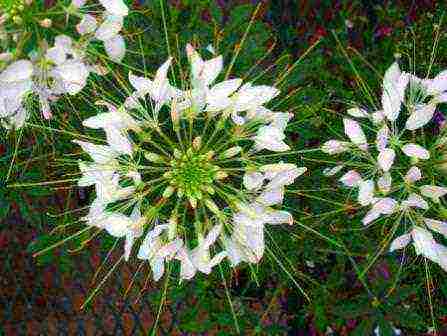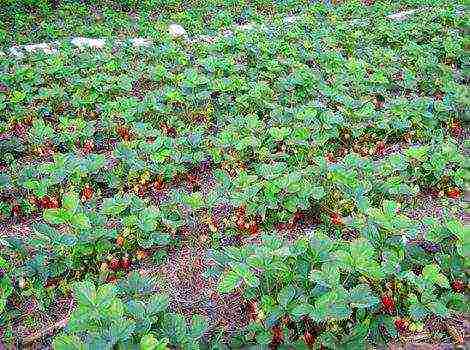Content [show]
Growing beautiful peonies in the garden
Peonies (lat. Paeonia) are decorative garden perennials, characterized by lush and fragrant flowering. In total, there are about 40 species in the culture. In modern floriculture, peonies are divided into two groups - herbaceous, in which the leaves and stems die off every season; and tree-like, preserving the terrestrial part all year round.
Herbaceous peony - cultivar EDULES SUPERBA
Today the collection of flower culture consists of more than 5 thousand varieties. On the territory of Russia, about 500 varieties of domestic and foreign selection are cultivated.
Yellow Grown hybrid peony
These plants reach a height of 60 to 100 cm. They have powerful roots and large dark green leaves. They can be of a wide variety of colors and shades: from pure white to burgundy with a white core.
Peony planting technology
Peonies are very popular among gardeners due to the variety of colors and delicate aroma of flowers. They are quite unpretentious; if desired, any florist can grow them on his site. The main thing is to prepare the ground and land in the right place, adhering to generally accepted technology.
Multi-petaled peony, Dolorodell cultivar
Seat selection
A perennial peony can be grown for decades without replanting. But, if he does not like the landing site, he will have to wait for flowering for a very long time.
Peonies, the planting of which consists of several stages, do not tolerate crowding, it is not advisable to plant them near fences and walls of buildings.This culture prefers open, flat terrain, well lit by the sun. The more light falls on the bush, the better it will bloom. In shady areas, peonies stretch out, and flower stalks bend from heavy buds and break.
When choosing a place, consider at what depth the groundwater is located. If at a level of 1 m or more, this can cause root rot and the death of the bush.
Preparing a pit for planting peonies
Peonies thrive on fertile soils, but prefer light loam with good drainage. The landing sites are prepared in advance - 15-20 days in advance, so that the substrate dries up and becomes denser.
On heavy, clayey soils, the pit is prepared 60 cm deep, and on light and loose ones - 50 cm, with a diameter of 60 by 70 cm, this depth will allow the bushes to quickly form strong roots that go deep into the soil.
Preparing a planting pit for peonies
When digging up a soil layer of 20 cm is laid separately, it is used to fix the plant. The bottom of the pit is laid out with expanded clay for drainage of water (can be replaced with broken brick or gravel).
Next, you need to add complementary foods. For its preparation, 300 grams of ash, 100 grams of potassium sulfate, and 100 grams of double superphosphate are added to 5-6 kg of humus. Peonies require medium acidity, ph value 6.5. If it is necessary to deoxidize the soil, add a liter of lime mixture (a kilogram of lime per bucket of water).
Planting peonies in autumn
The optimal time for planting herbaceous peonies in open ground is late summer and early autumn (from August 15 to September 5). It is better not to postpone the dates, since the flower will not have time to take root before the onset of stable cold weather.
Planting peonies in open ground
It is important to observe the depth when landing. It is recommended to place root tubers in the pit in this way: the upper bud of rhizome growth should be 3-5 cm below the soil surface.
To maintain the planting depth, you should use a special landing board. During the process, the board is installed over the pit and, adhering to the planned values, planting is carried out. If the flower is deepened more, it is fraught with the weakness of the plant, which will lead to poor flowering and frequent diseases.
The seedlings are placed in planting holes, the roots are spread. After that, it is covered with a mixture of soil and compost, mixed in equal parts. In this case, the plant is shaken a little in order to prevent the formation of voids between the layers of the soil mixture.
Peony flowers - planting and care, photo
When the planting of peonies in summer is completed, the earth is compacted with hands around the stem. Watered, spending 5-6 liters of water for each bush.
For herbaceous varieties, the optimal distance between bushes is 0.8-1.2 meters.
Herbaceous peonies: planting in spring and care
They start landing in the 2nd decade of April, until the air warms up above plus 10 grams. Celsius. At elevated temperatures, the buds immediately begin to grow, which significantly reduces the survival rate.
Pits for peonies are dug and prepared in advance, as soon as the snow melts. The rest of the procedure is the same as for the autumn-summer planting.
After planting, it is necessary to observe the plant and its adaptation. The lower leaves may wilt and need to be pinched off before they are affected by disease.
Herbaceous peonies - planting and care, photo
Features of planting a tree peony
Peonies of the tree group are classified as tall shrubs growing in height from 1.5-2 meters with straight massive light brown shoots. It is characterized by openwork feathery leaves and large flowers up to 25 cm in diameter. It blooms 10-15 days earlier than the herbaceous species, and is distinguished by relative frost resistance. Subject to the rules of care, it can be grown without transplanting from 20 to 50 years.
Tree peony - planting and care in the open field
A tree-like peony is planted using the same technology as a herbaceous one. Basically, they choose the period from September 1 to 15.The main difference between planting two types of plants is their size. For tree peonies, the distance between the bushes and to the nearest buildings or other plants should be 1.2-1.5 meters; a pit for them is prepared 10 cm larger in diameter and deeper.
Growing peonies in the open field
Planting and caring for peonies consists in observing all the rules of cultivation, organizing regulatory moisture and aeration of the soil, full dressing, as well as protection from parasites and infections.
Peony care during flowering
Watering and loosening the soil
Peonies are moisture-loving. They especially need watering during the period of bud formation. From April to June, if the summer is sultry, watering is organized once a decade, 20 liters per square meter. Due to this periodicity, plants form good renewal buds.
During and after flowering they are watered less often - twice a month, but more abundantly, making 1 sq. M. planting 40 liters of water. The soil in the near-trunk circles, as soon as the shoots appear, is constantly kept in a loose state. Loosen the soil carefully, not deeply, and not close to the roots, so as not to damage them.
Top dressing
In the first year after planting, young peonies, planting and caring for which does not cause difficulties, practically do not require additional fertilizing. During this period, the roots are actively developing, but poorly assimilate mineral fertilizers. It is recommended to make only foliar top dressing with Kemir or Baikal-M complex fertilizers.
In the spring, during active leaf growth (April and May), plants are sprayed with a solution of Agricola, according to the instructions for use. In mid-June, Ideal fertilizer is applied (2 tablespoons per bucket of water).
From the second year of life, the plants are fed systematically. In May, as soon as the leaves begin to bloom, humus or compost is embedded in the soil around the bush. As root dressings, I use nitrogen fertilizers, for example, urea diluted in water at the rate of 1 tbsp. 10 liters.
During the formation of peduncles, liquid organic matter (preferably mullein) is introduced with the addition of 1 tbsp. nitrophosphate on a bucket of working solution. Additionally, the leaves and buds are sprayed with the Bud preparation, and 1-2 glasses of ash are added to the trunk circles.
After flowering - in early August, the plants are watered with a solution of superphosphate and potassium sulfate, 1 tbsp each. each on a bucket of water.
Peony care during flowering
As a rule, peonies begin to bloom from the age of three. As soon as the buds reach the size of a pea, the plants are stepson - pluck out the side shoots, leaving one central one on each stem. To stimulate lush blooms.
Installation of supports for peonies
Most varieties form large inflorescences, the bushes often do not withstand their weight and lodge, especially during the rainy season. To support the plants, metal or plastic supports are installed. Faded peduncles are cut off at a level of 15 cm from the ground.
Pruning herbaceous and treelike peonies
Pruning of peonies is started 14 days after flowering. It is not recommended to prune only faded bushes, otherwise they will not have time to form buds for flowering next year. Faded peduncles are cut off at a level of 15 cm from the ground.
Pruning peonies after flowering
In late autumn, as soon as the first frosts hit, all the stems of the herbaceous peonies are cut off, leaving the cuttings 10 cm from the ground. The cut leaves and stems are removed and burned. And the soil in the trunks is sprinkled with humus and ash.
Treelike peonies are pruned in spring, in April. Dry and damaged branches are removed, and old ones are shortened by 10 cm. Shoots affected by frost are cut to a living bud. Once every 10 years, the rejuvenation of the bush is carried out, cutting off all the shoots to the base.
Protection from pests and diseases
The main disease of peonies is gray rot, it occurs if the soil under them is swampy, damp or acidic.An overabundance of nitrogen-containing substances can also be the cause of root decay.
To prevent disease in April or October, the bushes are sprayed with copper sulfate, 100 g per bucket of water. Before the peonies are planted in the ground, plots of rhizomes for 5 minutes. placed in a solution of the root formation stimulator Kornevin.
Another common flower disease is powdery mildew. From it, the plants are sprayed with colloidal sulfur, dissolving 40 g of the drug in 10 liters of water.
 Powdery mildew on peony leaves
Powdery mildew on peony leaves
Against rust, they are treated with Topaz fungicide or Bordeaux mixture - 100 g of concentrate are diluted in 10 liters of water.
Pests
Most often, peonies are annoyed by ticks, aphids and thrips. To combat them, the following drugs are used - Fitoverm, Agroverin and Confidor according to the instructions.
Methods and rules for breeding peonies
There are several methods by which herbaceous peonies are bred and propagated, planting and care in the open field is possible regardless of the method chosen. Basically, they choose to divide the bush and germinate cuttings, less often by layering.
Seed propagation is used only for the purpose of obtaining new varieties and forms in breeding farms. In gardening, it is not practiced, since varietal characteristics with seeds are practically not transmitted, and flowering occurs only 6-7 years after sowing.
Layers
Thus, bushes that have reached 6 years of age are propagated. Vertical layering is done in April when buds begin to develop. During the season, the bush is well looked after: they spud with fertile soil, organize frequent watering and good nutrition. At the end of summer, well-developed roots are formed on the stems.
Carefully, so as not to damage the buds, the shoots together with the roots are separated from the mother plant and planted in boxes or a greenhouse. Before winter, young plants are covered with peat, straw or spruce branches. Transplantation to flower beds is carried out in 1-2 years.
Cuttings
Rare varieties are propagated by cuttings, when, with an insufficient amount of planting material, you need to get a lot of seedlings. Cuttings are harvested from plants at the age of 4 years. About 15 cuttings are obtained from one such bush, and 30-35 from older ones.
Peony cuttings for reproduction
The best time for grafting is considered to be the period from late May to mid-June. The cut cuttings are kept for 8 hours in a solution of the Heteroauxin root formation stimulator (100 ml per 10 liters of water) and planted in a nursery or greenhouse.
By dividing the bush
Dividing the root system is the most effective way by which you can not only propagate, but also rejuvenate peonies that have been growing in one place for more than 8 years. The best period for dividing the peony bush is from August 15 to September 5.
Reproduction of peonies by division
The overgrown bush is first undermined with a shovel, trying not to injure a single root, and carefully removed from the ground. The rhizome is cleaned of the earthy clod by hand, if there is a lot of soil, it is washed off with water from the watering can.
Next, the peonies are left for 3-4 hours in a dry and sunny place so that the roots dry out and share more easily. Immediately before dividing, the shoots are shortened to a height of 10-15 cm from the ground. With the help of a peg, the bush is separated into two halves.
These areas are divided with a knife first into large divisions, and then into smaller ones with several buds, in the places of root plexus. At the same time, they try to save as many young roots that have grown from the rhizome.
The divided parts are placed in a growth stimulant solution for 8 hours, and planted in previously prepared planting holes.
When and how to transplant peonies
Garden peonies do not require frequent replanting. They painfully endure moving to a new place, to which they can adapt for 2-3 years. Plants are transplanted in case of emergency: improper or shallow planting, lack of flowering or its shallowness. Once every ten years, the bushes are planted by dividing the roots.
Transplanting peonies in autumn
The process begins in August or September. The bush is carefully dug out together with an earthen lump. The soil is washed off with water from a watering can or a hose. The cleaned plants are examined, removing diseased plants and shortening long roots. Places of cuts are treated with a 1% solution of potassium permanganate and sprinkled with crushed coal.
Preparing peonies for the winter season
Regardless of the type and climatic conditions, peonies, aged from planting to 3 years old, need shelter for the winter. More mature bushes can not be covered, but simply mulched with dry peat or humus.
Shelter of herbaceous peonies for the winter
They begin to build a shelter for herbaceous varieties as soon as a stable sub-zero temperature is established. The cut shoots are covered with loose earth or peat with a layer of 10 cm.
In the northern regions, the mulch layer is increased to 20 cm. The formed mound is additionally covered with spruce branches, straw or sawdust. In the spring, the shelter is removed.
Tree peonies are covered more thoroughly. First, the stems are pulled together with a cloth twine. Low young bushes are covered with spruce branches, burlap or covering material. Above, in order to protect the plant from wind and snow, a hut of spruce branches or branches of fruit trees is installed after pruning.
Tall shrubs are also tied. A frame made of wood is installed around the plant. The fence must necessarily correspond to the size of the bush or be slightly taller than it. The space between the frame and the plant is covered with dry foliage.
Outcome
Gorgeous peony flowers, planting and caring for which are available even to a novice gardener without special skills, will decorate any garden. Follow the recommendations given in the article, provide the plants with appropriate care, and in a few years your garden will be decorated with abundant and lush flowering of beautiful peonies.
The beauty of blooming peonies is so mesmerizing that it is literally impossible to tear yourself away from it. Variety in color and shape: you can find both snow-white semi-double or burgundy anemone-shaped buds, and pink double and scarlet pink-shaped. For peonies, they always try to take the best place in the garden. Let's figure out how finicky the peony is, and what kind of care it needs.
When to transplant peonies outdoors
As mentioned earlier, the optimal time for planting peonies is autumn, or rather September. Preparation for planting in the ground should begin in August, but the transplant itself is postponed until the second half of September.
Let's see why:
- By this time, the kidneys are completely formed.
- The top of the bush stops growing. Goes into sleep state.
- Small roots are also formed. Minimal risk of injury to the root system of the plant.
- Hot weather is not expected, which is welcome when transferring.
- September is a rainy season, which increases the possibility of rooting when a peony is planted.
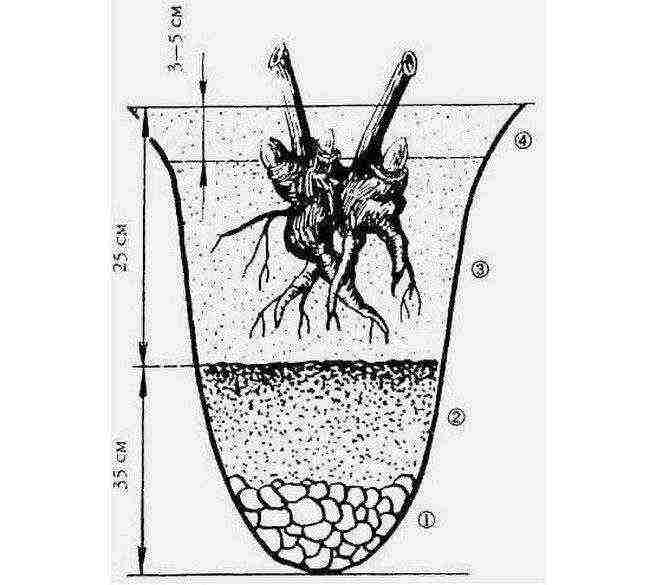 Choosing a place for growing peonies in the open field
Choosing a place for growing peonies in the open field
For good growth and rooting, the peony needs to create certain conditions - choose the right place, how to transplant. There are some recommendations from experienced gardeners:
- The site should be well lit, the plant loves the sun.
- The flower is afraid of draft and wind. Planting should be carried out next to trees or shrubs, providing enough space for the root system of the flower.
- It is not recommended to plant a peony near the house - it is destructive for him. The plant does not tolerate overheating well, and heat constantly emanates from the walls of the house. The peony should be two meters from the house.
Fresh articles about garden and vegetable garden
The choice of soil for growing peonies in the open field
The composition of the soil is very important for a peony. There are some professional tips to help you choose your soil:
- For peony, loamy soil is preferable.
- Heavy, clayey soil is lightened by sand, peat and humus. In such soil, the plant will feel great.
- Humus and clay are added to the sandy soil.
- Peaty lands are detrimental to peonies, but if you add ash, sand and organic matter to them, then they are suitable for growing a flower.
Peony planting technology in open ground
Due to the fact that the peony bush will grow in one place for several years and grow, you should plan 1-2 m2 of planting area for each plant. Planting holes are dug 50-60 cm deep and 70-80 cm in diameter.
At the bottom of the hole, drainage is poured from large expanded clay, crushed stone or broken brick.
Then a mound is poured from a mixture of excavated earth mixed with rotted manure or compost (5-6 kg), wood ash (0.5 liter can) and potassium-phosphorus fertilizers (for example, 100 g of potassium sulfate and double superphosphate).
The seedling is lowered into the pit, the roots are spread, directing them down, and covered with the remaining earth. At the same time, the growth point is deepened by 3-5 cm. With a deeper planting, the plant will be weak, prone to frequent diseases, flowering will be poor or absent altogether.
In order not to be mistaken with depth, it is convenient to use a boarding board or a stick. It is placed across the hole and the desired length is measured.
After planting, the plants are watered, spending 10 liters of water for each. At the same time, the soil settles, so the hole is filled up with earth and mulched with peat or straw.
Top dressing of peonies in the open field
In the first year after planting, young peonies, planting and caring for which does not cause difficulties, practically do not require additional fertilizing. During this period, the roots are actively developing, but poorly assimilate mineral fertilizers. It is recommended to make only foliar top dressing with Kemir or Baikal-M complex fertilizers.
In the spring, during active leaf growth (April and May), plants are sprayed with a solution of Agricola, according to the instructions for use. In mid-June, Ideal fertilizer is used (2 tablespoons per bucket of water).
From the second year of life, the plants are fed systematically. In May, as soon as the leaves begin to bloom, humus or compost is embedded in the soil around the bush. As root dressings, I use nitrogen fertilizers, for example, urea diluted in water at the rate of 1 tbsp. l. 10 liters.
During the formation of peduncles, liquid organic matter (preferably mullein) is introduced with the addition of 1 tbsp. l. nitrophosphate on a bucket of working solution. Additionally, the leaves and buds are sprayed with the Bud preparation, and 1-2 glasses of ash are added to the trunk circles.
After flowering - in early August, plants are watered with a solution of superphosphate and potassium sulfate, 1 tbsp each. l. each on a bucket of water.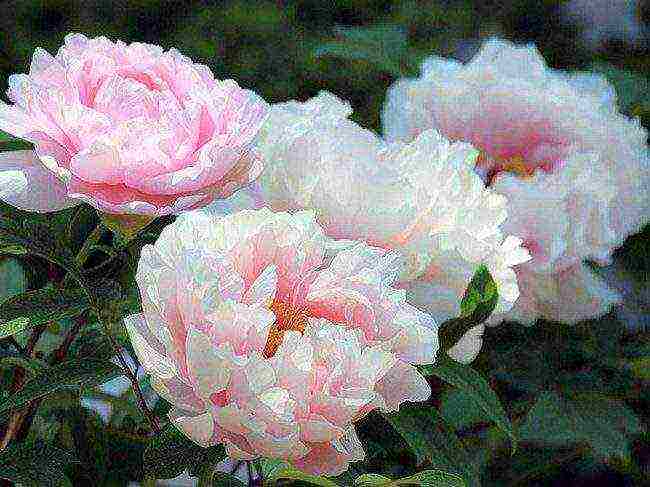
Diseases and pests of peonies in the open field
Of all the existing diseases, peonies most often suffer from gray rot - botrytis. This disease manifests itself in mid-May by rotting stems, although both buds and leaves can be affected by Botrytis - parts of the plant are covered with gray mold. Excess nitrogen, tightness in the flower bed and rainy weather contribute to the appearance of gray rot. Diseased areas should be cut and burned away from all plants. As a preventive measure, spraying with a solution of copper sulfate (50 g per 10 L of water) or garlic water (10 g of crushed garlic per 1 L of water) is used. You need to spray both the plant and the soil around the bush.
Sometimes peonies are infected with powdery mildew - a fungal disease that affects the leaves of peonies and covers them with a white bloom. Powdery mildew should be fought by spraying the bush with soapy water (200 g of laundry soap, 20 g of copper sulfate per 10 liters of water).
Watering peonies in the open field
Watering is carried out in moderate doses. In addition, peonies react painfully to the proximity of groundwater. They prefer loose, permeable and nutritious soil. At a time when peonies are blooming and in hot, dry weather, the amount of watering is increased.
Please note that watering the flower in the heat is necessary only at the root, avoiding moisture on the leaves.
Articles about unusual growing seedlings
Weeding peonies in the open field
Weeding is one of the most important conditions for the healthy growth of a peony. Timely removal of weeds has a positive effect on the development and appearance of the plant. Carefully process the soil around the peony, just do not cut the flower itself.
Peony care during flowering
As a rule, peonies begin to bloom from the age of three. As soon as the buds reach the size of a pea, the plants are stepson - pluck out the side shoots, leaving one central one on each stem. To stimulate lush blooms.
Most varieties form large inflorescences, the bushes often cannot withstand their weight and lodge, especially during the rainy season. To support the plants, metal or plastic supports are installed. Faded peduncles are cut off at a level of 15 cm from the ground.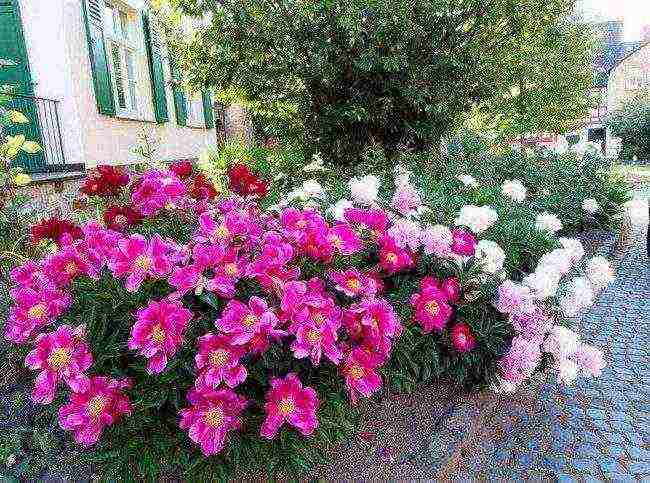
Transplanting and reproduction of peonies in the open field
They say that under favorable conditions, peonies can live up to a hundred years. However, this does not mean that the plant sticks to one place. Once every 5-6 years, peonies are transplanted to a new place. Do not be alarmed that you will have to plant a flower all over the site. After a few years, you can return the plant to its original location.
Of the two options when you can transplant peonies, in spring or autumn, choose the one that is more convenient for you. The main thing is to remember that a magnificent handsome man experiences an autumn transplant easier and easier than a spring one.
Important! A flower transplanted in spring is sick for a long time and does not bloom, and a flower that has moved to a new place in the fall gets time to adapt and begins to grow rapidly with the first spring drop.
Reproduction of peonies
Reproduction of peonies by seeds
You are already familiar with the vegetative propagation of peonies by the method of dividing a bush. Peonies propagate in other ways, for example, by seed. But it should be remembered that peony seeds do not always retain varietal qualities, therefore, as a rule, only breeders use them. And plants grown from seeds bloom only in the fourth or fifth year. But if you want to try to breed a new variety, then sow freshly harvested seeds in August directly into loose soil, and they will germinate next spring.
Articles about growing seedlings
Propagation of peonies by root cuttings
This is the most reliable way of breeding peonies. A small piece of rhizome with a dormant bud is separated from the bush in July, planted, and by September it has already taken root. True, for those who are in a hurry, this method is not suitable: such shoots develop slowly and for the first time they will be able to bloom in five years.
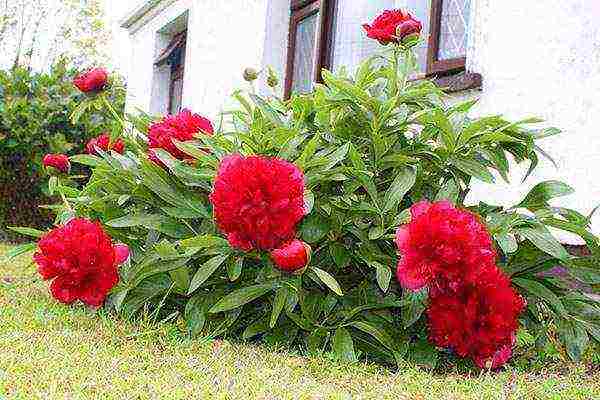 The history of growing peonies has more than two millennia, during which a great many varieties and varieties have been created. But no matter how much the peonies have changed, planting and caring for them in the open field has not undergone major changes since then.
The history of growing peonies has more than two millennia, during which a great many varieties and varieties have been created. But no matter how much the peonies have changed, planting and caring for them in the open field has not undergone major changes since then.
To admire the lush carved foliage and spectacular flowering year after year, the summer resident will have to master all the intricacies of agricultural technology and find out the preferences of these amazing ornamental plants.
All species of peonies that exist in nature are natives of Eurasia and the American continent, represented by herbaceous perennials and dwarf shrubs. In Russian gardens, plants have long proven their unpretentiousness and the ability to grow and bloom in one place from 10 to 20 years without transplanting.
A place for planting and caring for peonies in the open field
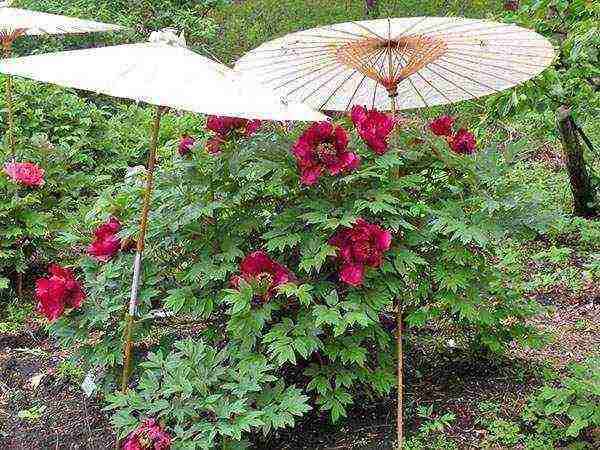 A place for planting peonies is chosen so that the plant is as comfortable as possible for not only one season, but also several years. Since this culture belongs to light and heat-loving, up to 3 hours a day it can endure a transparent garden shade, but is afraid of cold winds and drafts, the peony is selected a site according to its requirements and shading for the hottest, noon hours.
A place for planting peonies is chosen so that the plant is as comfortable as possible for not only one season, but also several years. Since this culture belongs to light and heat-loving, up to 3 hours a day it can endure a transparent garden shade, but is afraid of cold winds and drafts, the peony is selected a site according to its requirements and shading for the hottest, noon hours.
For several years, the root system of peonies can deepen to 70–80 cm. To simplify the care of peonies in the open field, before planting, pay attention to the danger of flooding the site and stagnation of scarlet or groundwater.Constant humidity greatly increases the risk of root rot and the death of the entire bush.
Actively growing peonies need space, tightness leads to a deterioration in flowering, the appearance of diseases and pests.
Peony planting conditions:
- Planting holes are made at a distance of at least 1–1.5 meters from shrubs and other perennial plants.
- A gap of at least 2-3 meters is left to the nearest tree.
- Do not plant peonies directly under the walls of buildings and fences.
- Between the bushes, depending on the type and variety, they leave from 70 to 180 cm of free space.
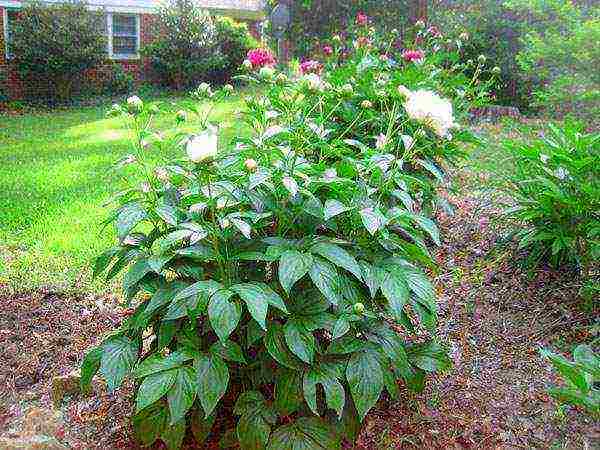 A bright, wind-protected area has been found, it's time to take care of the soil in which the peony is to grow. Soil with a neutral or slightly acidic reaction should be loose, aerated, nutritious. Sandy soil is flavored with humus, peat, wood ash and deoxidized with dolomite flour. Mix in garden soil as needed. Dense clay soil can be made more airy with river sand and a little peat. The sand is used to structure the nutritious but rapidly caking black soil.
A bright, wind-protected area has been found, it's time to take care of the soil in which the peony is to grow. Soil with a neutral or slightly acidic reaction should be loose, aerated, nutritious. Sandy soil is flavored with humus, peat, wood ash and deoxidized with dolomite flour. Mix in garden soil as needed. Dense clay soil can be made more airy with river sand and a little peat. The sand is used to structure the nutritious but rapidly caking black soil.
Rules for planting peonies for outdoor care
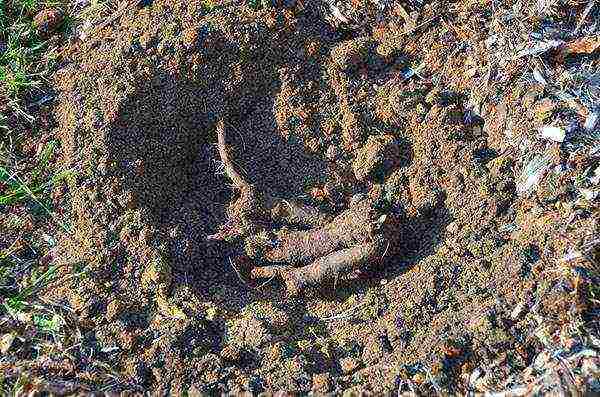 Unlike many horticultural crops, when planting it is important to leave the growth point on or above the soil, peonies deeply deepen. The buds, from which the stems will subsequently develop, are sunk into it by 3–7 cm, depending on the density of the soil.
Unlike many horticultural crops, when planting it is important to leave the growth point on or above the soil, peonies deeply deepen. The buds, from which the stems will subsequently develop, are sunk into it by 3–7 cm, depending on the density of the soil.
If this is not done, the most sensitive and important part of the plant will be unprotected in rain, snow and sun. However, even with an excessively deep planting of a peony in open ground, caring for it can be not only laborious, but also in vain. Such plants form lush foliage in spring, but bloom weakly or refuse to form buds altogether.
Peony planting rules:
- Planting pits for peonies are made up to 80 cm deep for tree-like plants and up to 60 cm for more common herbaceous varieties. The width of the pit is 60 and 50 cm, respectively.
- The bottom, in order to avoid stagnation of water, is covered with drainage.
- The pit is filled two-thirds with the prepared substrate mixed with 100-150 grams of superphosphate, one spoonful of ferrous sulfate and a liter jar of bone meal or sifted wood ash.
- When the straightened peony roots fall into the ground, they are covered with loose soil by another 15–20 cm so that the buds are reliably hidden below the ground level.
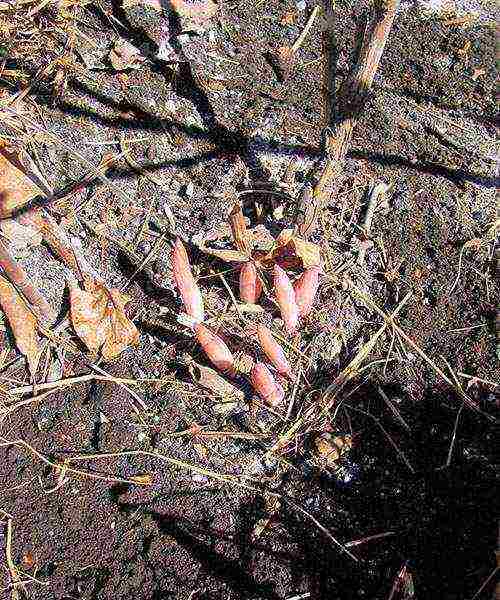 Outdoor peony care in spring or autumn begins immediately after planting. The soil is carefully compacted and watered at the rate of 8-10 liters of water per bush. If the plants are ahead of autumn rooting and wintering, they are thickly mulched with a 10-centimeter layer of peat. With the onset of spring, care for the perennial continues.
Outdoor peony care in spring or autumn begins immediately after planting. The soil is carefully compacted and watered at the rate of 8-10 liters of water per bush. If the plants are ahead of autumn rooting and wintering, they are thickly mulched with a 10-centimeter layer of peat. With the onset of spring, care for the perennial continues.
Planting peonies in the ground: spring or autumn
The most convenient planting time for a florist and favorable for a peony is the beginning of autumn. By this time, the root system of the perennial grows, and it itself recovers after flowering and accumulates strength.
If you plan to plant in the open ground and care for peonies in the fall, it should be carried out 30-40 days before the onset of stable cold weather. In this case, an adult transplanted plant or a young seedling obtained from dividing a bush is guaranteed to take root and does not freeze in winter.
 The timing of planting of decorative perennials depends on the characteristics of the climate of a particular region. The shorter the summer, the earlier it is worth taking care of the preparation of pits and planting material.
The timing of planting of decorative perennials depends on the characteristics of the climate of a particular region. The shorter the summer, the earlier it is worth taking care of the preparation of pits and planting material.
Landing dates:
- Planting of peonies in open ground in Siberia takes place in August, September and October, and in the northern regions it ends 1.5–2 months earlier than in the south.
- In the Urals, where the weather is extremely changeable, seedlings are brought into the ground from the second half of August to mid-September.
- A week later, you can plant flowering perennials in the middle lane and in the North-West of the country.
- And in the south of Russia, peonies without fear for the condition of the plant can be planted from September to mid-October.
When buying seedlings from a nursery or because of the early arrival of cold weather, planting is postponed to spring. Unfortunately, if the plants have an open root system, they do not tolerate this procedure very well. Peonies weakened after wintering take a long time to acclimatize, and sometimes even over the whole summer they cannot recover.
In order to exclude unpleasant consequences, planting of peonies in the ground in the spring is carried out very early, in the soil moist after the snow melts, until the hot weather sets in, and the plants themselves do not grow.
The exception is peonies with a closed root system in containers. They can be planted without fear from spring to autumn.
Caring for peonies after planting in open ground
 Vegetation of peonies begins in early May and ends in late autumn. Caring for peonies in the open field in spring begins with very gentle loosening of the soil, watering, if necessary, and fertilizing.
Vegetation of peonies begins in early May and ends in late autumn. Caring for peonies in the open field in spring begins with very gentle loosening of the soil, watering, if necessary, and fertilizing.
Peonies are watered infrequently, but very abundantly, in order to completely wet the earthen lump and the roots that braid it. Since the plant has to grow foliage and prepare for flowering, the peony needs complete mineral fertilizers and nitrogen.
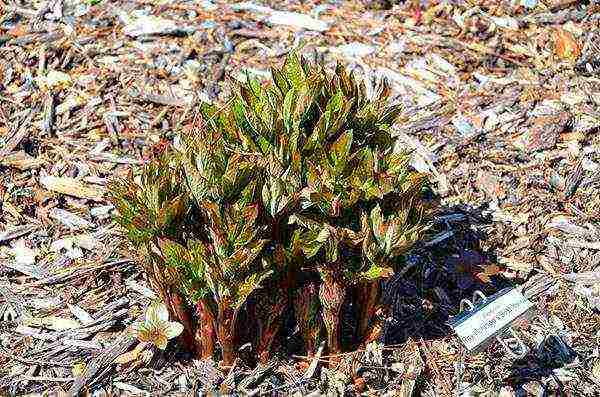 Top dressing of peonies in the open field is done on wet ground. In order for the mixture to quickly get to the suction roots, a shallow hole is made around the bush at a distance of 10-15 cm, into which the solution is poured. In the summer, especially for young plants that have not reached the age of 3-4 years, foliar top dressing with urea is useful. They are introduced three times at intervals of 15–20 days from the moment the shoots appear.
Top dressing of peonies in the open field is done on wet ground. In order for the mixture to quickly get to the suction roots, a shallow hole is made around the bush at a distance of 10-15 cm, into which the solution is poured. In the summer, especially for young plants that have not reached the age of 3-4 years, foliar top dressing with urea is useful. They are introduced three times at intervals of 15–20 days from the moment the shoots appear.
In dry periods, peonies are watered at the rate of 10-15 liters per bush. It is especially important to maintain soil moisture in the first month after spring planting.
On blooming peonies, wilted flowers are regularly removed. On young plants less than 3 years old, any weak buds are also removed. All summer I weed the area under perennials, and in the fall, before the onset of cold weather, the shoots are cut off, and the soil is mulched. If the planting is carried out correctly, and the plants receive competent and sufficient care, the first flowering of the peony will begin in 2-3 years, gradually becoming brighter and more magnificent.
Planting a peony in autumn - video
Growing beautiful peonies in the garden
Peonies (lat. Paeonia) are decorative garden perennials, characterized by lush and fragrant flowering. In total, there are about 40 species in the culture. In modern floriculture, peonies are divided into two groups - herbaceous, in which the leaves and stems die off every season; and tree-like, preserving the ground part all year round.
Herbaceous peony - cultivar EDULES SUPERBA
Today the collection of flower culture consists of more than 5 thousand varieties. About 500 varieties of domestic and foreign selection are cultivated on the territory of Russia.
Yellow Grown hybrid peony
These plants reach a height of 60 to 100 cm. They have powerful roots and large dark green leaves. They can be of a wide variety of colors and shades: from pure white to burgundy with a white core.
Peony planting technology
Peonies are very popular among gardeners due to the variety of colors and delicate aroma of flowers. They are quite unpretentious; if desired, any grower can grow them on his site. The main thing is to prepare the ground and land in the right place, adhering to generally accepted technology.
Multi-petaled peony Dolorodell cultivar
Seat selection
A perennial peony can be grown for decades without replanting. But, if he does not like the landing site, he will have to wait for flowering for a very long time.
Peonies, the planting of which consists of several stages, do not tolerate tightness, it is not advisable to plant them near fences and walls of buildings. This culture prefers open, flat terrain, well lit by the sun. The more light falls on the bush, the better it will bloom.In shady areas, peonies stretch out, and flower stalks bend from heavy buds and break.
When choosing a place, consider at what depth the groundwater is located. If at a level of 1 m or more, this can cause root rot and the death of the bush.
Preparing a pit for planting peonies
Peonies thrive on fertile soils, but prefer light loam with good drainage. The landing sites are prepared in advance - 15-20 days in advance, so that the substrate dries up and becomes denser.
On heavy, clayey soils, the pit is prepared 60 cm deep, and on light and loose ones - 50 cm, with a diameter of 60 by 70 cm, this depth will allow the bushes to quickly form strong roots that go deep into the soil.
Preparing a planting pit for peonies
When digging, a 20 cm layer of soil is laid separately, it is used to fix the plant. The bottom of the pit is laid out with expanded clay for drainage of water (can be replaced with broken brick or gravel).
Next, you need to add complementary foods. For its preparation, 300 grams of ash, 100 grams of potassium sulfate, and 100 grams of double superphosphate are added for 5-6 kg of humus. Peonies require medium acidity, ph value 6.5. If it is necessary to deoxidize the soil, add a liter of lime mixture (a kilogram of lime per bucket of water).
Planting peonies in autumn
The optimal time for planting herbaceous peonies in open ground is late summer and early autumn (from August 15 to September 5). It is better not to postpone the dates, since the flower will not have time to take root before the onset of stable cold weather.
Planting peonies in open ground
It is important to observe the depth when landing. It is recommended to place root tubers in the pit in this way: the upper bud of rhizome growth should be 3-5 cm below the soil surface.
To maintain the planting depth, you should use a special boarding board. During the process, the board is installed over the pit and, adhering to the planned values, planting is carried out. If the flower is deepened more, it is fraught with the weakness of the plant, which will lead to poor flowering and frequent diseases.
The seedlings are placed in planting holes, the roots are spread. Then they are covered with a mixture of soil and compost, mixed in equal parts. In this case, the plant is shaken a little in order to prevent the formation of voids between the layers of the soil mixture.
Peony flowers - planting and care, photo
When the planting of peonies in summer is completed, the earth is compacted with hands around the stem. Watered, spending 5-6 liters of water for each bush.
For herbaceous varieties, the optimal distance between bushes is 0.8-1.2 meters.
Herbaceous peonies: planting in spring and care
They start landing in the 2nd decade of April, until the air warms up above plus 10 grams. Celsius. At elevated temperatures, the buds immediately begin to grow, which significantly reduces the survival rate.
Pits for peonies are dug and prepared in advance, as soon as the snow melts. The rest of the procedure is the same as for the autumn-summer planting.
After planting, it is necessary to observe the plant and its adaptation. The lower leaves may wilt and need to be pinched off before they are affected by disease.
Herbaceous peonies - planting and care, photo
Features of planting a tree peony
Peonies of the tree group are classified as tall shrubs growing in height from 1.5-2 meters with straight massive light brown shoots. It is characterized by openwork feathery leaves and large flowers up to 25 cm in diameter. It blooms 10-15 days earlier than the herbaceous species, and is distinguished by relative frost resistance. Subject to the rules of care, it can be grown without transplanting from 20 to 50 years.
Tree peony - planting and care in the open field
A tree-like peony is planted using the same technology as a herbaceous one. Basically, they choose the period from September 1 to 15. The main difference between planting two types of plants is their size.For tree peonies, the distance between the bushes and to the nearest buildings or other plants should be 1.2-1.5 meters; a pit for them is prepared 10 cm larger in diameter and deeper.
Growing peonies in the open field
Planting and caring for peonies consists in observing all the rules of cultivation, organizing regulatory moisture and aeration of the soil, full dressing, as well as protection from parasites and infections.
Peony care during flowering
Watering and loosening the soil
Peonies are moisture-loving. They especially need watering during the period of bud formation. From April to June, if the summer is sultry, watering is organized once a decade, 20 liters per square meter. Due to this periodicity, plants form good renewal buds.
During and after flowering, it is watered less often - twice a month, but more abundantly, making 1 sq.m. planting 40 liters of water. The soil in the near-trunk circles, as soon as the shoots appear, is constantly kept in a loose state. Loosen the soil carefully, not deeply, and not close to the roots, so as not to damage them.
Top dressing
In the first year after planting, young peonies, planting and caring for which does not cause difficulties, practically do not require additional fertilizing. During this period, the roots are actively developing, but poorly assimilate mineral fertilizers. It is recommended to make only foliar top dressing with Kemir or Baikal-M complex fertilizers.
In the spring, during active leaf growth (April and May), plants are sprayed with a solution of Agricola, according to the instructions for use. In mid-June, Ideal fertilizer is applied (2 tablespoons per bucket of water).
From the second year of life, the plants are fed systematically. In May, as soon as the leaves begin to bloom, humus or compost is embedded in the soil around the bush. As root dressings, I use nitrogen fertilizers, for example, urea diluted in water at the rate of 1 tbsp. 10 liters.
During the formation of peduncles, liquid organic matter (preferably mullein) is introduced with the addition of 1 tbsp. nitrophosphate on a bucket of working solution. Additionally, the leaves and buds are sprayed with the Bud preparation, and 1-2 glasses of ash are added to the trunk circles.
After flowering - in early August, plants are watered with a solution of superphosphate and potassium sulfate, 1 tbsp each. each on a bucket of water.
Peony care during flowering
As a rule, peonies begin to bloom from the age of three. As soon as the buds reach the size of a pea, the plants are stepchild - pluck out the side shoots, leaving one central one on each stem. To stimulate lush bloom.
Installation of supports for peonies
Most varieties form large inflorescences, the bushes often do not withstand their weight and lodge, especially during the rainy season. To support the plants, metal or plastic supports are installed. Faded peduncles are cut off at a level of 15 cm from the ground.
Pruning herbaceous and treelike peonies
Pruning of peonies is started 14 days after flowering. It is not recommended to prune only faded bushes, otherwise they will not have time to form buds for flowering next year. Faded peduncles are cut off at a level of 15 cm from the ground.
Pruning peonies after flowering
In late autumn, as soon as the first frost hits, all the stems of the herbaceous peonies are cut off, leaving the cuttings 10 cm from the ground. The cut leaves and stems are removed and burned. And the soil in the trunks is sprinkled with humus and ash.
Treelike peonies are pruned in spring, in April. Dry and damaged branches are removed, and old ones are shortened by 10 cm. Shoots affected by frost are cut to a living bud. Once every 10 years, the rejuvenation of the bush is carried out, cutting off all the shoots to the base.
Protection from pests and diseases
The main disease of peonies is gray rot, it occurs if the soil under them is swampy, damp or acidic. An overabundance of nitrogen-containing substances can also be the cause of root decay.
To prevent disease in April or October, the bushes are sprayed with copper sulfate, 100 g per bucket of water. Before the peonies are planted in the ground, plots of rhizomes for 5 minutes. placed in a solution of the root formation stimulator Kornevin.
Another common flower disease is powdery mildew. From it, the plants are sprayed with colloidal sulfur, dissolving 40 g of the drug in 10 liters of water.
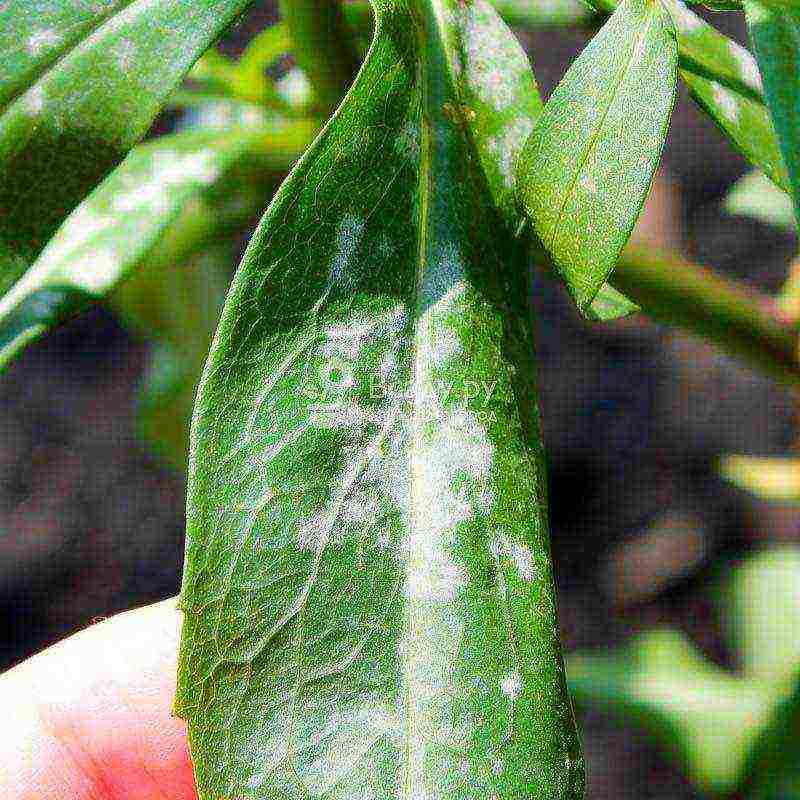 Powdery mildew on peony leaves
Powdery mildew on peony leaves
Against rust, they are treated with Topaz fungicide or Bordeaux mixture - 100 g of concentrate are diluted in 10 liters of water.
Pests
Most often, peonies are annoyed by ticks, aphids and thrips. To combat them, the following drugs are used - Fitoverm, Agroverin and Confidor according to the instructions.
Methods and rules for breeding peonies
There are several methods by which herbaceous peonies are bred and propagated, planting and care in the open field is possible regardless of the method chosen. Basically, they choose to divide the bush and germinate cuttings, less often by layering.
Seed propagation is used only for the purpose of obtaining new varieties and forms in breeding farms. In gardening, it is not practiced, since varietal characteristics with seeds are practically not transmitted, and flowering occurs only 6-7 years after sowing.
Layers
Thus, bushes that have reached 6 years of age are propagated. Vertical layering is done in April when buds begin to develop. During the season, the bush is well looked after: they spud with fertile soil, organize frequent watering and good nutrition. At the end of summer, well-developed roots are formed on the stems.
Carefully, so as not to damage the buds, the shoots together with the roots are separated from the mother plant and planted in boxes or a greenhouse. Before winter, young plants are covered with peat, straw or spruce branches. Transplantation to flower beds is carried out in 1-2 years.
Cuttings
Rare varieties are propagated by cuttings, when, with an insufficient amount of planting material, you need to get a lot of seedlings. Cuttings are harvested from plants at the age of 4 years. About 15 cuttings are obtained from one such bush, and 30-35 from older ones.
Peony cuttings for reproduction
The best time for grafting is considered to be the period from late May to mid-June. The cut cuttings are kept for 8 hours in a solution of the Heteroauxin root formation stimulator (100 ml per 10 liters of water) and planted in a nursery or greenhouse.
By dividing the bush
Dividing the root system is the most effective way by which you can not only propagate, but also rejuvenate peonies that have been growing in one place for more than 8 years. The best period for dividing the peony bush is from August 15 to September 5.
Reproduction of peonies by division
The overgrown bush is first undermined with a shovel, trying not to injure a single root, and carefully removed from the ground. The rhizome is cleaned of the earthy clod with hands, if there is a lot of soil, it is washed off with water from the watering can.
Next, the peonies are left for 3-4 hours in a dry and sunny place so that the roots dry out and share more easily. Immediately before dividing, the shoots are shortened to a height of 10-15 cm from the ground. With the help of a peg, the bush is separated into two halves.
These areas are divided with a knife first into large divisions, and then into smaller ones with several buds, in the places of root plexus. At the same time, they try to save as many young roots that have grown from the rhizome.
The divided parts are placed in a growth stimulant solution for 8 hours, and planted in previously prepared planting holes.
When and how to transplant peonies
Garden peonies do not require frequent replanting. They painfully endure moving to a new place, to which they can adapt for 2-3 years. Plants are transplanted in case of emergency: improper or shallow planting, lack of flowering or its shallowness. Once every ten years, the bushes are planted by dividing the roots.
Transplanting peonies in autumn
The process begins in August or September.The bush is carefully dug out together with an earthen lump. The soil is washed off with water from a watering can or a hose. The cleaned plants are examined, removing diseased plants and shortening long roots. Places of cuts are treated with a 1% solution of potassium permanganate and sprinkled with crushed coal.
Preparing peonies for the winter season
Regardless of the species and climatic conditions, peonies, aged from planting to 3 years old, need shelter for the winter. More mature bushes can not be covered, but simply mulched with dry peat or humus.
Shelter of herbaceous peonies for the winter
They begin to build a shelter for herbaceous varieties as soon as a stable sub-zero temperature is established. The cut shoots are covered with loose earth or peat with a layer of 10 cm.
In the northern regions, the mulch layer is increased to 20 cm. The formed mound is additionally covered with spruce branches, straw or sawdust. In the spring, the shelter is removed.
Tree peonies are covered more thoroughly. First, the stems are pulled together with a cloth twine. Low young bushes are covered with spruce branches, burlap or covering material. Above, in order to protect the plant from wind and snow, a hut of spruce branches or branches of fruit trees is installed after pruning.
Tall shrubs are also tied. A frame made of wood is installed around the plant. The fence must necessarily correspond to the size of the bush or be slightly higher than it. The space between the frame and the plant is covered with dry foliage.
Outcome
Gorgeous peony flowers, planting and caring for which are available even to a novice gardener without special skills, will decorate any garden. Follow the recommendations given in the article, provide the plants with appropriate care, and in a few years your garden will be decorated with abundant and lush flowering of beautiful peonies.
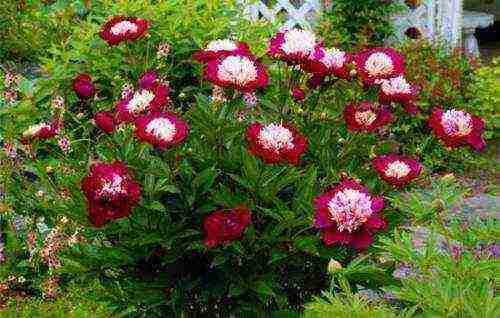
Peonies, one of the most popular ornamental plants, will be a great decoration for any garden. Their spectacular bright flowers with a delicate aroma look great against the background of dark green leaves.
Due to the unpretentiousness, longevity and frost resistance of peonies, they allow even a novice florist to grow these beautiful flowers.
Planting peonies in the open field (photo)
How to choose a place in the garden for peonies
To determine where to plant these flowers correctly on your site, it is important to know the following nuances:
1. Perennial peonies can be grown in a permanent place without transplanting for several years. However, despite the unpretentiousness, in order to obtain lush flowering, you should still take into account some of the nuances when planting peonies in open ground. It is undesirable to plant them along fences, walls of buildings, as they need space and good lighting.
In the shade, peonies stretch out, peduncles bend under the weight of flowers and break. Most often, under such conditions, the plant ceases to bloom altogether.
If you plant peonies on the south side of the site, then the flowers will quickly fade in the sun. Therefore, the best option for their placement would be open, slightly shaded areas, protected from the wind;
2. In terms of soil composition, light loams with a slightly acidic reaction are optimal for peonies (pH = 5.5-6.5). Heavy clay soils before planting must be "refined" - add coarse sand, dolomite flour or lime (1 kg / m2). If sandy loam predominates on the site, then clay is added to them. In both cases, rotted manure or compost is applied to increase soil fertility;
3. Depth of groundwater: at a high level (1 m and above), it is necessary to drain the site.
Planting dates for peonies
Peonies are planted mainly in autumn, and in rare cases in spring... The optimal planting time is from the second half of August to the second week of September. Before the onset of frost, the seedlings will have time to grow young sucking roots and get stronger.
In the spring, peonies are planted after the snow melts, before the buds begin to grow.If planted with already awakened buds, then such a plant will lag behind in development from seedlings planted in the fall.
Peony planting technology
Due to the fact that the peony bush will grow in one place for several years and grow, you should plan 1-2 m2 of planting area for each plant. Planting holes are dug 50-60 cm deep and 70-80 cm in diameter.
At the bottom of the hole, drainage is poured from large expanded clay, crushed stone or broken brick.
Then a mound is poured from a mixture of excavated soil mixed with rotted manure or compost (5-6 kg), wood ash (0.5 liter can) and potassium-phosphorus fertilizers (for example, 100 g of potassium sulfate and double superphosphate).
The seedling is lowered into the pit, the roots are spread, directing them down, and covered with the remaining earth. At the same time, the growth point is deepened by 3-5 cm. With a deeper planting, the plant will be weak, prone to frequent diseases, flowering will be poor or absent altogether.
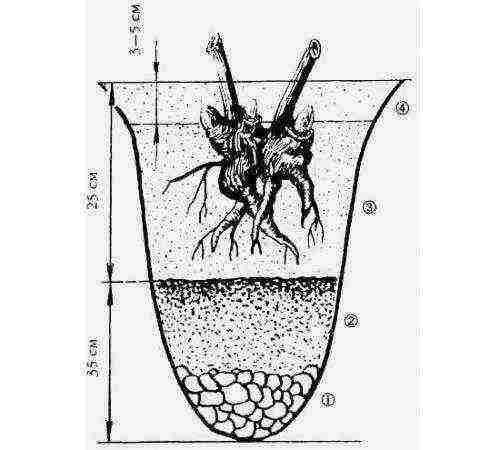
Planting a peony: 1 - drainage; 2 - mineral-organic soil mixture; 3 - garden land; 4 - the level of deepening of the seedling neck
In order not to be mistaken with depth, it is convenient to use a boarding board or a stick. It is placed across the hole and the desired length is measured.
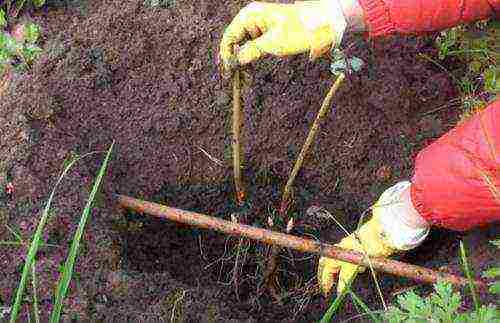
Using a stick to determine the planting depth of a peony seedling
After planting, the plants are watered, spending 10 liters of water for each. At the same time, the soil settles, so the hole is filled up with earth and mulched with peat or straw.
How to propagate peonies
There are several ways to breed peonies.
Seed method used in breeding work to obtain new varieties. In addition, plants grown from seeds do not retain the varietal characteristics of their “parents” and bloom in 6-7 years of vegetation.
Layers mature flourishing bushes can be propagated. To do this, the bush, as the shoots grow during the season, are spilled 2-3 times to a height of 30-4 cm, watered abundantly and fed.

Peony bush
The buds on such stems are removed. Such activities will give the plant the opportunity to lay flower and vegetative buds and form thin roots on the lower part of the stems. At the end of August, the ground around the shoots is carefully raked, separated from the mother plant and transplanted into a box or greenhouse. For the winter they are covered with mulch (straw, peat). They are planted on flower beds in a year.
Cuttings rare varieties are propagated. At the same time, a lot of planting material can be obtained from one plant (15-35 cuttings). Harvesting is carried out from bushes over 4 years old 10-15 days before the start of flowering. The optimal period for cuttings is the end of May - mid-June. Each cutting should have 2 internodes.

Scheme for cutting cuttings from peony stems
For better rooting, the cuttings are kept for 7-8 hours in a solution of heteroauxin or root and then planted obliquely in a greenhouse to a depth of 3-4 cm and at a distance of 7-10 cm from each other. The first 10-15 days they are sprayed 3 times a day. Rooting occurs in 1.5-2 months. Before wintering, seedlings are mulched with peat, sawdust, shavings, and chopped straw.
Dividing the bush - the simplest and most effective way of breeding peonies. The best period for this is from August 15 to September 10. Divide the bushes that have been growing in one place for more than 8 years. This procedure will also rejuvenate them.
The selected plant is undermined from all sides with a garden pitchfork (root trauma will be less than when using a shovel) and carefully pull the bush out of the ground. The soil is shaken off from the rhizome, and its remnants are washed off with water from a watering can or a hose. After that, the dug out bush is left to dry in a dry place for 3-5 hours. Before dividing, the tops are cut to 10-15 cm.
The rhizome is divided into parts so that each of them has 2-3 growth buds on the root collar and at least 15 cm long roots. Places of cuts on the roots are powdered with charcoal powder and left to dry. Then they are planted in a prepared place.
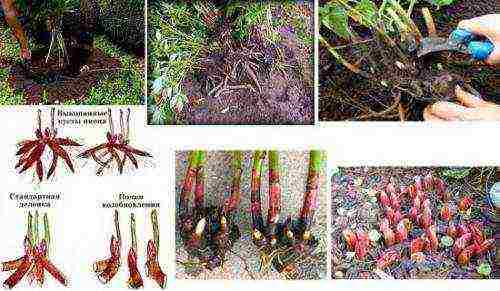
Dividing the peony bush
Outdoor peonies care (photo)
Even a beginner in floriculture can take care of peonies. During the period of active growth in spring, budding and flowering peonies need constant abundant watering... One bush consumes 1-2 buckets of water at a time. Peonies are watered every 10 days until the end of summer. After watering the ground in near-trunk circles loosen.
Peonies love good nutrition, which differs depending on the age of the plants.
Young peonies (up to 3 years old), when planting which nutrients were added to the planting pits, do not need additional root feeding. To build up the leaf mass in the spring during the emergence of seedlings, you can spray with a solution of complex fertilizers. Repeat after 2 weeks.
If the planting technology has been violated, then feeding will have to start already in the first year of the growing season. In April, planting peonies is watered with a mullein solution (1:10) with the addition of 200 g of superphosphate and 300 g of wood ash. Instead of this "cocktail", you can use a nitrophoska (100g / m2). The second feeding is carried out in mid-May. For the third time (in mid-June), phosphorus and potassium-containing preparations are introduced.
Adult flowering peonies have a different nutritional requirement. In the spring they need nitrogen and potassium. As such substances, ammonium nitrate and potassium sulfate (60g / m2) can be scattered around the bushes. The second time the plants are fed during the budding period with complex fertilizers (Kemira-universal, Agricola, etc.). After flowering, peonies are watered with a solution of phosphorus-potassium fertilizers.
Important! All dressings are applied after watering the plants (with the exception of those scattered over the snow).
Peony flower stalks have several buds. To achieve larger flowers, the lateral buds are plucked out. Thanks to this, the central flower will be large. Often the stems do not support the weight of the blossoming inflorescences and tilt towards the ground. Therefore, it is necessary to install a circular support around the bush to prevent it from falling apart.

An example of a circular support for peony bushes
The faded flower heads are periodically removed.
After the plant has completely faded and loses its decorative effect, no matter how much you want, you do not need to cut the tops. During this period, peonies begin to lay new buds, and the presence of leaves for photosynthesis is very important at this time.
Only in the fall, when there is a massive yellowing of the ground part of the bush, it is cut off to 10-15 cm from the ground level.
After that, young plants are mulched with peat or chopped straw. Adult plants do not need shelter.
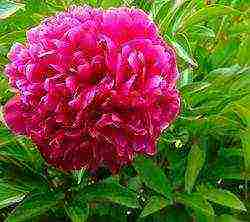 The Chinese are sure that the gods themselves patronize the cultivation of these flowers. Peonies: planting and care in the open field - how to do it right.
The Chinese are sure that the gods themselves patronize the cultivation of these flowers. Peonies: planting and care in the open field - how to do it right.
Description: varieties and varieties of peony
Luxurious peonies familiar to everyone with a magnificent aroma bloom in spring. Bloom usually coincides with graduation parties in schools. The last hours of school are saturated with sadness and the piercing, intoxicating scent of these beautiful plants.

Maryin root
The known flowers belong to herbaceous varieties, which are subdivided in turn:
- Dodging peonies - this group includes Maryin root.
- Medicinal peonies. Varieties of this group of species are subshrub plants and Lemoine peonies, which belong to tree peonies.
- White-flowered (double and non-double forms, Japanese, anemone).
- Terry (crown, pink, spherical, hemispherical, etc.).
Herbaceous peonies
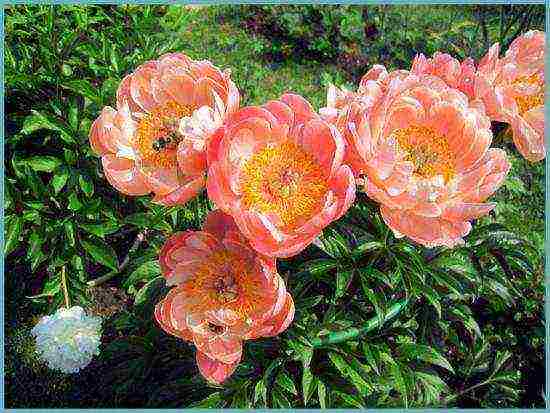
Peonies of unusual cream color
The cultivation of herbaceous peonies is not difficult: perennial plants can do without transplanting for over 20 years.
Important! A correctly chosen place for planting peonies is a guarantee of exuberant flowering of perennial bushes.
Modern herbaceous peonies are bred by breeders in a wide variety of shapes and colors. There are over 5,000 varieties of this crop. Usually the plant height is from 0.3 to 1.5 m.The diameter of the flower is slightly different for different honeycomb species. The color of the petals of herbaceous peonies is of all shades of pink, white, burgundy-red.
The appearance of the bush, even without flowers, already serves as a decoration for the site. The leaves of peonies are juicy green on long petioles, form lush spreading bushes that look great both in individual plantings and when decorating compositions in landscape design.
Peonies of the following types are successfully used for outdoor gardening:
- Vitmana - the petals are yellowish;
- Milk-flowered peony - white petals; the middle part of the flower is open; stamens are yellow;
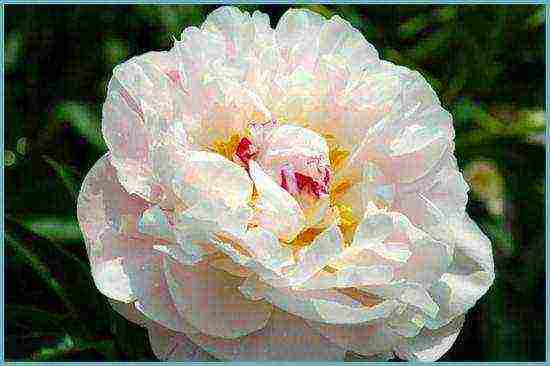
Milk-flowered peony
- Medicinal peony - ruby red petals;
- Thin-leaved peony - dark red petals with shades;
- Maryin root is a flower with dark purple petals.
There is a classification of herbaceous peonies by the height of the bush, which includes 4 groups: low (height up to 60 cm); medium (up to 80 cm); tall (up to 1 m); giants (up to 1.5 m).
In addition, herbaceous peonies differ in the duration and timing of flowering: early; medium, medium late; late varieties. Planting peonies of different flowering periods on the site will allow you to have plants flowering for 2 months.
Peony flowers differ not only in the shape, shade of the petals, the timing of flowering, but even in the shape of the stamens.
Tree peonies
Treelike peonies form a special group of plants. These plants are widespread in eastern countries - in China and Japan. In recent years, this species has been cultivated in our country when grown in the open field.
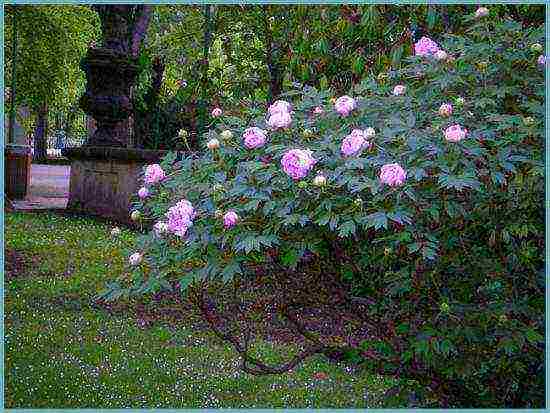
Tree peony
Unlike herbaceous peonies, tree varieties do not have dying shoots. The height of the tree peony bush can reach 2 m.
Decorative tree peonies are divided into 3 groups:
- Plants with double flowers (Sino-European varieties). These peonies have a wide range of petal colors. Terry buds, flowers are heavy. With the abundant flowering of peonies of this group, the plant droops under the weight of the buds, therefore, the installation of supporting supports is often required: this somewhat reduces the decorative effect of the bush.

Terry peony
- Yellow and Delaway hybrid peonies. Peonies belonging to this group are widely used in landscape design. This is due to the fact that the flowers are yellow, which is rare for peonies. Bright flowers in combination with openwork foliage serve as a decoration for garden areas.

Hybrid yellow peony
- Japanese varietal peonies (with double and semi-double flowers). These plants with light colors of different shades are gaining more and more popularity in the arrangement of flower beds.

Japanese terry peonies
Tree peonies grow more slowly than herbaceous ones, so the price of planting material is somewhat more expensive.
Currently, breeders have bred a large number of varietal tree-like peonies that can not only bloom beautifully, but also withstand the harsh Russian winters.
Planting a plant
Planting peonies in the open field is most favorable in early autumn. During the growing season, the peonies have grown stronger, the plant has formed many new roots, which increases the chances of survival of the bushes.
Transplanting peonies in the fall. An open, sunny place is suitable for peonies. Given that the plant has been developing in one place for many years, a sufficient distance between the bushes should be provided. Wetlands or places with high groundwater levels are not suitable for planting crops.
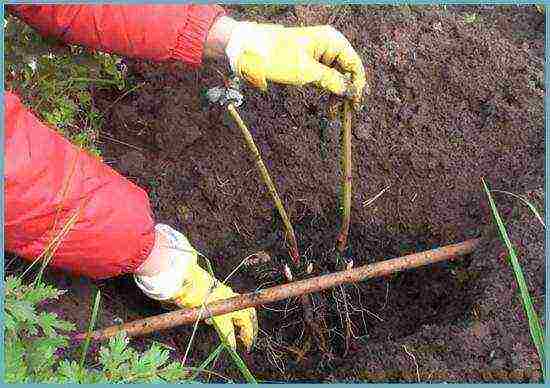
Planting a peony bush in a permanent place
The plant is planted in a pre-prepared hole. For this, the garden soil must be selected to a depth of 1-2 shovel bayonets. The pit needs to be filled with a fertile soil mixture: peat, humus, turf soil and sand are mixed in equal parts. 1 cup of double superphosphate, 0.5 liters of ash and iron vitriol (1 tablespoon) are added to the mixture for planting peonies.
For better survival of peony bushes, it is required to treat the plant roots with a special clay talker, which consists of natural clay, 2 tablets of heteroauxin and copper sulfate. A liquid clay dough is kneaded, into which the root system of a peony cut is dipped when planting in the open field. This operation increases the survival rate of young peony plants in a new place.
Important! Peony roots are very fragile. Transplanting plants with a high degree of care is required.
Young plants are not buried - the upper buds are covered with soil only 3-5 cm. The first watering of the planted divisions should be abundant. The top of the planting pit is mulched with peat chips or garden soil - it is important to maintain soil moisture for better root survival.
Planting peonies in spring - will not cause problems if the rules are followed.
There is an opinion that planting peonies in the open field in spring is fraught with great difficulties and setbacks. Plants that have started to grow get sick longer, often the death of the transplanted plants occurs.
Important! A spring crop transplant should be planned as early as possible. Transplanting peonies in the spring should be carried out in early April, immediately after the snow melts.
Before planting, pits are dug, the depth of which is at least 70 cm, and the diameter is over 0.5 m. Drainage from fine gravel and coarse sand is laid at the bottom of the pit. The pit is filled with a fertile nutrient mixture with the addition of fertilizers. The plant is dug up with a clod of earth, located in a hole strictly vertically. It is not allowed to cover the upper buds with soil at a distance of more than 10 cm.
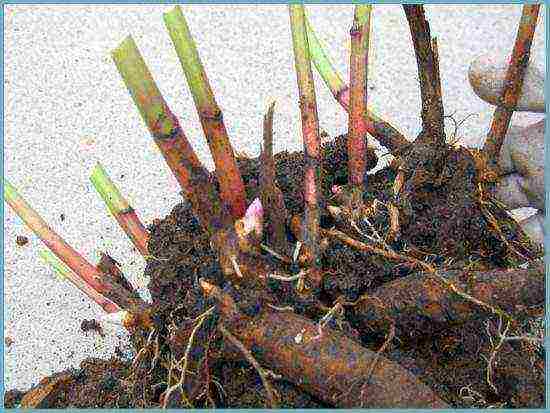
Peony bush before transplanting
Subject to the rules of spring transplantation, the plants start growing together, grow well in summer and begin to bloom the next year.
Plant care
Caring for peonies is reduced to regular watering, loosening the soil under the bushes and timely feeding.
Peonies require at least 5 hours of sunlight per day. When shaded, they bloom poorly, stagnate and get sick, so you need to monitor the growth of nearby plants, the shadow of which can interfere with the growing season of peony bushes.
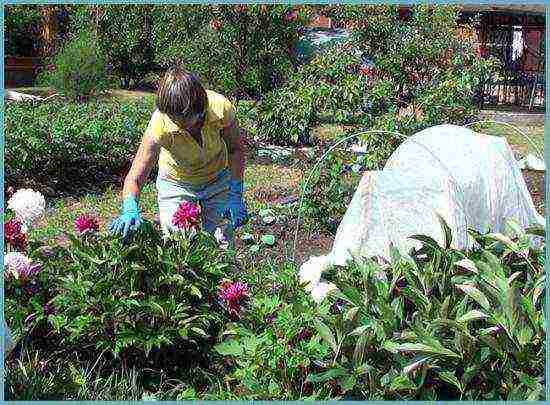
Inspect peony bushes regularly for disease
You cannot grow a crop in one place for over 10 years. Peonies become smaller, flowering decreases and the development of diseases is observed.
To preserve the decorative effect of the peony bush, it is required to periodically remove faded peduncles and damaged leaves.
To increase the size of the flower, it is useful to leave one central bud on the peduncle, plucking out the rest.
Reproduction of a peony
Reproduction of peony bushes is allowed to be done vegetatively (by dividing the bush, cuttings, layering, grafting) and seeds.
Each method has its positive and negative sides. So, reproduction by grafting is justified on rare, expensive varieties of tree peonies.
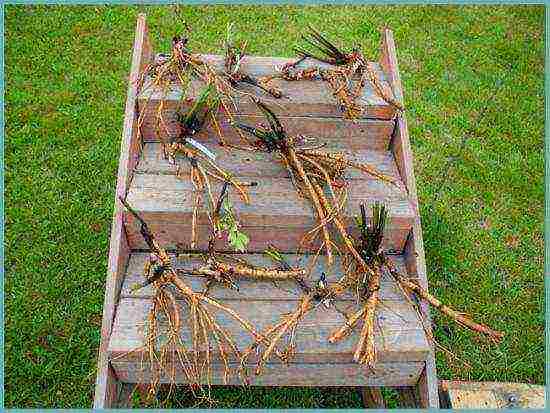
Split peony bushes
The easiest way to get new plants is to divide the peony bushes. It should be remembered that good planting material is obtained by dividing healthy, mature bushes older than 5 years.
Reproduction of a tree peony by layering allows you to quickly get young plants that correspond to the variety. A mature and strong shoot with several buds is selected for layering. Rooting is carried out in wet moss, sand or soil, it is sometimes useful to use a greenhouse.
Seed propagation is most common in breeding work and breeding new varieties.
Fertilizing and feeding peony
The cultivation of lush peony bushes, pleasing to the eye with annual exuberant flowering, directly depends on what kind of care is provided to the plant. One of the necessary measures to maintain the health and full flowering of the plant is the introduction of dressings, which are divided into two types: foliar and root.
Foliar feeding of peonies
Fertilization of crops with foliar feeding is carried out by spraying the nutrient solution over the green mass of the plant. The greatest effect of this procedure is observed when spraying plants in the early morning hours or in cloudy weather.
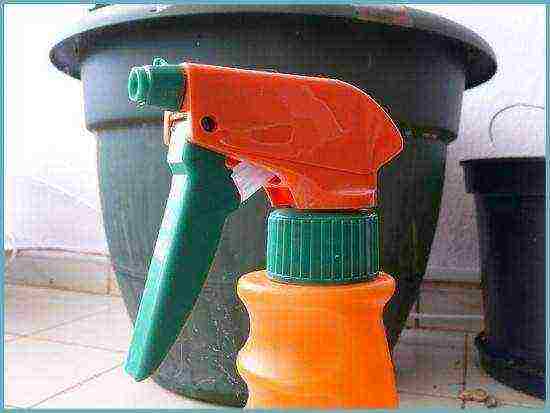
Foliar dressing is spraying the ground part of the plant with nutrients from a spray bottle
During the summer period, three foliar feeding of peonies is carried out with various fertilizers:
- 1st feeding is carried out by spraying the plants with a urea solution;
- 2nd feeding is carried out using urea mixed with mineral fertilizers;
- The 3rd feeding of peonies is carried out with a solution of mineral fertilizers.
Organic fertilizers: mullein (1:10 dilution) or bird death (1:25 dilution), are used for adult plants during the budding period.
Root feeding of peonies

Root feeding of peony bushes
The introduction of nutrients under the peony bushes during the growing season is carried out 3 times:
- During March-April, fertilization of plantings of peonies is carried out by the introduction of mineral fertilizers (scattered over the top layer of the soil). Melt snow water gradually dissolves the fertilizer granules, which slowly penetrate through the soil to the roots.
- Summer dressing of bushes is carried out 2 times per season, while dry fertilizer is scattered under the bushes on the ground and watered abundantly.
Diseases and pests
The decorative qualities of peonies suffer greatly from diseases and pests that affect plants, especially if the agricultural technology of growing crops is not followed.
Among diseases of peonies fungal and viral diseases are leading: rust, gray rot, leaf spot, circular leaf mosaic.
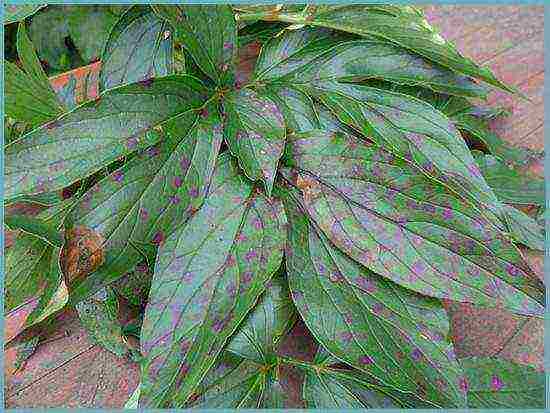
Peony spotting
Diseases can be prevented by providing careful planting care: timely watering and periodic loosening of the soil, the introduction of the necessary fertilizers, the timely removal of dead plant parts. With a high level of groundwater, reliable drainage should be provided, which will save the long roots of peonies from getting wet.
Fungicide treatment will help prevent the development of fungal diseases. Excellent results are observed with early spraying of plants with Bordeaux mixture or systemic fungicides. For the prevention of leaf mosaic, peony bushes should be treated with Alirin.

Preparation of a composition for combating diseases of peonies
Peonies get damaged plant pests: aphids, bronzes, beetles, root nematodes and caterpillars. For pest control, iron and copper sulfate, green soap, karbofos, fufanon, actellik and other preparations are used.
The destruction of beetles and caterpillars is most reliable to carry out manually, carefully examining each bush of peonies.
Timely care of the plant will ensure its long life and lush flowering.
Peonies: combination with other plants
Taking into account that the peony is a perennial plant, the root system of which is quite delicate, when planting in open ground, it should be provided for the proximity to suitable perennials. Companion flowers should be in harmony with peonies in color. So, lilac veronica, oak sage, catnip, popovnik or cuff are suitable for white or pale pink peonies. A perfect combination is achieved by planting peonies next to miniature conifers. Growing perennial plants next to peony bushes should not oppress the bushes and interfere with the formation of the root system.
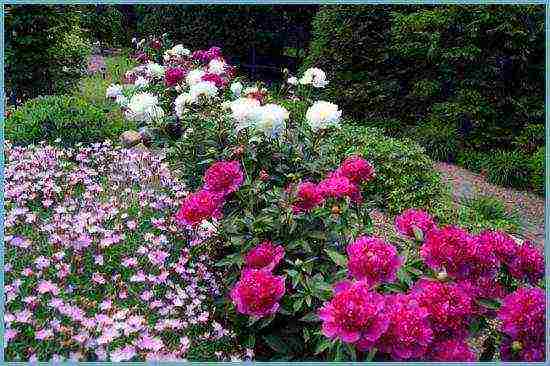
Peonies in the flowerbed
A great combination is achieved by planting peonies next to hosts, but remember that the host cannot tolerate long-term exposure to sunlight. Such a neighborhood is possible with light shading, on the eastern side of the site.
Peonies in landscape design
Peonies are so decorative that single plantings are pleasing to the eye on their own. In landscape design, planting peony bushes on an emerald lawn is appropriate.Peonies look great next to perennial shrubs.
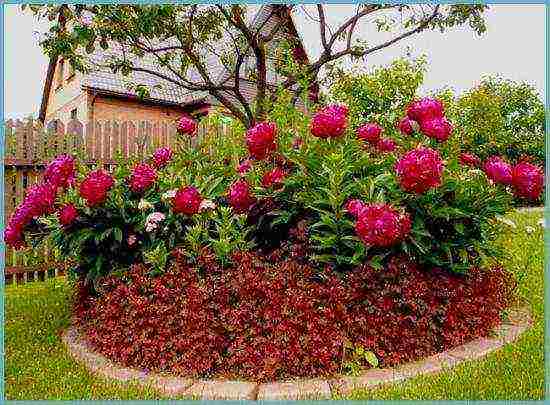
Peonies in landscape design
The design of the territories should take into account the short flowering period of peonies, provide for planting bright, blooming summer crops next to the bushes. Growing peonies is a fun and affordable activity even for a novice florist.
Planting a peony: video
Peony varieties: photo
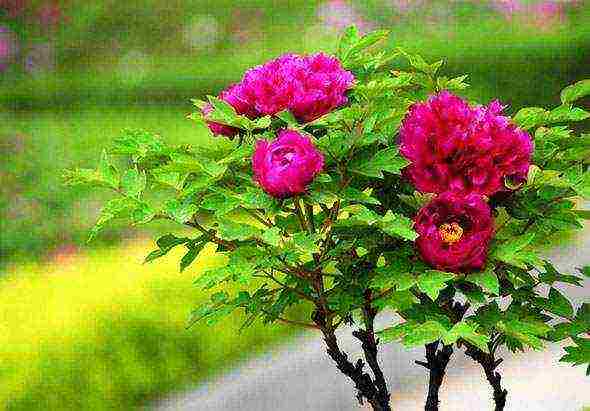



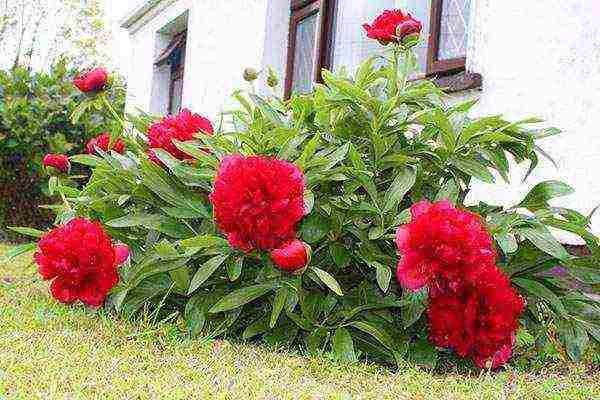 The history of growing peonies has more than two millennia, during which a great many varieties and varieties have been created. But no matter how much the peonies have changed, planting and caring for them in the open field has not undergone major changes since then.
The history of growing peonies has more than two millennia, during which a great many varieties and varieties have been created. But no matter how much the peonies have changed, planting and caring for them in the open field has not undergone major changes since then.
To admire the lush carved foliage and spectacular flowering year after year, the summer resident will have to master all the intricacies of agricultural technology and find out the preferences of these amazing ornamental plants.
All species of peonies that exist in nature are natives of Eurasia and the American continent, represented by herbaceous perennials and dwarf shrubs. In Russian gardens, plants have long proven their unpretentiousness and the ability to grow and bloom in one place from 10 to 20 years without transplanting.
A place for planting and caring for peonies in the open field
 A place for planting peonies is chosen so that the plant is as comfortable as possible for not only one season, but also several years. Since this culture belongs to light and heat-loving, up to 3 hours a day it can endure a transparent garden shade, but is afraid of cold wind and draft, the peony is selected a site according to its requirements and shading for the hottest, noon hours.
A place for planting peonies is chosen so that the plant is as comfortable as possible for not only one season, but also several years. Since this culture belongs to light and heat-loving, up to 3 hours a day it can endure a transparent garden shade, but is afraid of cold wind and draft, the peony is selected a site according to its requirements and shading for the hottest, noon hours.
For several years, the root system of peonies can deepen to 70–80 cm. To simplify the care of peonies in the open field, before planting, pay attention to the danger of flooding the site and stagnation of scarlet or groundwater. Constant humidity greatly increases the risk of root rot and the death of the entire bush.
Actively growing peonies need space, tightness leads to a deterioration in flowering, the appearance of diseases and pests.
Peony planting conditions:
- Planting holes are made at a distance of at least 1–1.5 meters from shrubs and other perennial plants.
- A gap of at least 2-3 meters is left to the nearest tree.
- Do not plant peonies directly under the walls of buildings and fences.
- Between the bushes, depending on the type and variety, they leave from 70 to 180 cm of free space.
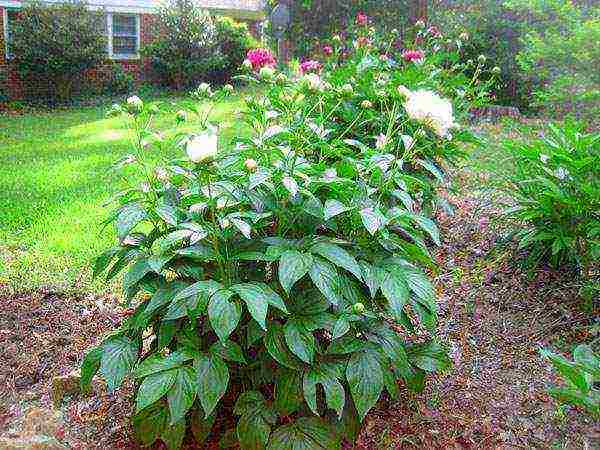 A bright, wind-protected area has been found, it's time to take care of the soil in which the peony is to grow. Soil with a neutral or slightly acidic reaction should be loose, aerated, nutritious. Sandy soil is flavored with humus, peat, wood ash and deoxidized with dolomite flour. Mix in garden soil as needed. Dense clay soil can be made more airy with river sand and a little peat. The sand is used to structure the nutritious but rapidly caking black soil.
A bright, wind-protected area has been found, it's time to take care of the soil in which the peony is to grow. Soil with a neutral or slightly acidic reaction should be loose, aerated, nutritious. Sandy soil is flavored with humus, peat, wood ash and deoxidized with dolomite flour. Mix in garden soil as needed. Dense clay soil can be made more airy with river sand and a little peat. The sand is used to structure the nutritious but rapidly caking black soil.
Rules for planting peonies for outdoor care
 Unlike many horticultural crops, when planting which it is important to leave the growth point at the level of the soil or above it, peonies deeply deepen. The buds, from which the stems will subsequently develop, are sunk into it by 3–7 cm, depending on the density of the soil.
Unlike many horticultural crops, when planting which it is important to leave the growth point at the level of the soil or above it, peonies deeply deepen. The buds, from which the stems will subsequently develop, are sunk into it by 3–7 cm, depending on the density of the soil.
If this is not done, the most sensitive and important part of the plant will be unprotected in rain, snow and sun. However, even with an excessively deep planting of a peony in open ground, caring for it can be not only laborious, but also in vain. Such plants form lush foliage in spring, but bloom weakly or refuse to form buds altogether.
Peony planting rules:
- Planting pits for peonies are made up to 80 cm deep for tree-like plants and up to 60 cm for more common herbaceous varieties. The width of the pit is 60 and 50 cm, respectively.
- The bottom, in order to avoid stagnation of water, is covered with drainage.
- The pit is filled two-thirds with the prepared substrate mixed with 100-150 grams of superphosphate, one spoonful of ferrous sulfate and a liter jar of bone meal or sifted wood ash.
- When the straightened peony roots fall into the ground, they are covered with loose soil by another 15–20 cm so that the buds are reliably hidden below the ground level.
 Outdoor peony care in spring or autumn begins immediately after planting. The soil is carefully compacted and watered at the rate of 8-10 liters of water per bush. If the plants have autumn rooting and wintering ahead, they are thickly mulched with a 10-centimeter layer of peat. With the onset of spring, care for the perennial continues.
Outdoor peony care in spring or autumn begins immediately after planting. The soil is carefully compacted and watered at the rate of 8-10 liters of water per bush. If the plants have autumn rooting and wintering ahead, they are thickly mulched with a 10-centimeter layer of peat. With the onset of spring, care for the perennial continues.
Planting peonies in the ground: spring or autumn
The most convenient planting time for a florist and favorable for a peony is the beginning of autumn. By this time, the root system of the perennial grows, and it itself recovers after flowering and accumulates strength.
If you plan to plant in the open ground and care for peonies in the fall, it should be carried out 30-40 days before the onset of stable cold weather. In this case, an adult transplanted plant or a young seedling obtained from dividing a bush is guaranteed to take root and does not freeze in winter.
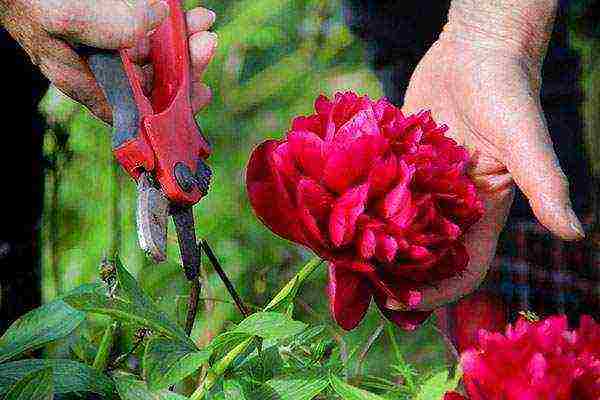 The timing of planting of decorative perennials depends on the characteristics of the climate of a particular region. The shorter the summer, the earlier it is worth taking care of the preparation of pits and planting material.
The timing of planting of decorative perennials depends on the characteristics of the climate of a particular region. The shorter the summer, the earlier it is worth taking care of the preparation of pits and planting material.
Landing dates:
- Planting of peonies in open ground in Siberia takes place in August, September and October, and in the northern regions it ends 1.5–2 months earlier than in the south.
- In the Urals, where the weather is extremely changeable, seedlings are brought into the ground from the second half of August to mid-September.
- A week later, you can plant flowering perennials in the middle lane and in the North-West of the country.
- And in the south of Russia, peonies without fear for the condition of the plant can be planted from September to mid-October.
When buying seedlings from a nursery or because of the early arrival of cold weather, planting is postponed to spring. Unfortunately, if the plants have an open root system, they do not tolerate this procedure very well. Peonies weakened after wintering take a long time to acclimatize, and sometimes even over the whole summer they cannot recover.
In order to exclude unpleasant consequences, planting of peonies in the ground in the spring is carried out very early, in the soil moist after the snow melts, until the hot weather sets in, and the plants themselves do not grow.
The exception is peonies with a closed root system in containers. They can be planted without fear from spring to autumn.
Caring for peonies after planting in open ground
 Vegetation of peonies begins in early May and ends in late autumn. Caring for peonies in the open field in spring begins with very gentle loosening of the soil, watering, if necessary, and fertilizing.
Vegetation of peonies begins in early May and ends in late autumn. Caring for peonies in the open field in spring begins with very gentle loosening of the soil, watering, if necessary, and fertilizing.
Peonies are watered infrequently, but very abundantly, in order to completely wet the earthen lump and the roots that braid it. Since the plant has to grow foliage and prepare for flowering, the peony needs complete mineral fertilizers and nitrogen.
 Top dressing of peonies in the open field is done on wet ground. In order for the mixture to quickly get to the suction roots, a shallow hole is made around the bush at a distance of 10-15 cm, into which the solution is poured. In the summer, especially for young plants that have not reached the age of 3-4 years, foliar top dressing with urea is useful. They are introduced three times at intervals of 15–20 days from the moment the shoots appear.
Top dressing of peonies in the open field is done on wet ground. In order for the mixture to quickly get to the suction roots, a shallow hole is made around the bush at a distance of 10-15 cm, into which the solution is poured. In the summer, especially for young plants that have not reached the age of 3-4 years, foliar top dressing with urea is useful. They are introduced three times at intervals of 15–20 days from the moment the shoots appear.
In dry periods, peonies are watered at the rate of 10-15 liters per bush. It is especially important to maintain soil moisture in the first month after spring planting.
On blooming peonies, wilted flowers are regularly removed. On young plants less than 3 years old, any weak buds are also removed. All summer I weed the area under perennials, and in the fall, before the onset of cold weather, the shoots are cut off, and the soil is mulched.If the planting is carried out correctly, and the plants receive competent and sufficient care, the first flowering of the peony will begin in 2-3 years, gradually becoming brighter and more magnificent.
Planting a peony in autumn - video

